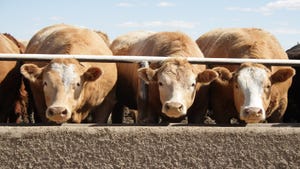July 29, 2011

The Noble Foundation has launched a new online resource to assist farmers and ranchers who are enduring one of the worst droughts since the Dust Bowl.
Noble Foundation agricultural consultants have developed www.noble.org/drought, a Web page that will serve as a central repository for information to assist agricultural producers in managing their properties and resources throughout this difficult situation.
“This is a once-in-a-generation drought,” said Billy Cook, senior vice president and director of the Agricultural Division. “We haven’t seen this type of heat and lack of precipitation since the record-setting drought of the mid-1950s or even the Dust Bowl. Lloyd Noble established the Noble Foundation to assist producers after he witnessed the devastating effects of the Dust Bowl. Decades later, we’re equipped with the knowledge and experience to help farmers and ranchers successfully endure this drought.”
Information for the special Web page was developed by the Noble Foundation’s agricultural consultants, who have been inundated with hundreds of calls concerning drought management since the beginning of July. Additional information was gathered from university researchers and agricultural experts from around the country. The Web page will be updated as long as the drought persists.
The Web page will provide countless aspects of drought management from safeguarding pastures and destocking to tax implications and wildlife concerns. “This is a comprehensive resource that should answer many of the questions that come with struggling through this drought,” said Hugh Aljoe, consultation program manager for the Noble Foundation. “This is reliable information that will help farmers and ranchers meet their specific challenges. Of course, the Noble Foundation consultants are always here to help in person, too.”
While the drought stretches across 14 states from Florida to Arizona, the three states experiencing the worst conditions are Oklahoma, Texas and Louisiana. At the end of July, the United States Department of Agriculture (USDA) declared 74 of Oklahoma’s 77 counties a natural disaster area. USDA had already declared all 254 counties in Texas a natural disaster area by June.
According to the United States Drought Monitor, the entire state of Oklahoma is in at least a moderate drought; more than 75 percent of the state is considered either in a severe or extreme drought; and 42 percent is rated in exceptional drought, the highest level possible. Exceptional drought is defined as widespread crop/pasture loss and water shortages creating emergencies.
Comparatively, only about 5 percent of Oklahoma faced nothing more than moderate drought conditions at this same time last year. Since 2000, Oklahoma has experienced “exceptional” drought conditions only two other years (2006 and 2008). In both instances, less than 20 percent of the state was affected.
South of the Red River, Texas has more than 91 percent of its state in extreme or exceptional drought. Texas climatologist John Nielsen-Gammon has been cited as saying that if the drought continues until September, this could be the worst drought in state history since recordkeeping began in 1895.
La Nina effect
The extremely dry and hot weather patterns are caused by a La Nina effect, which is an abnormal cooling of Pacific waters that prevents moisture from reaching the southern portion of the United States. “The four months following Thanksgiving were the driest in Oklahoma since 1921, and Texas has experienced a similar record dry spell,” Aljoe said. “There has been very little precipitation in the region since September of 2010, and weather projections say that the trend of warm weather and little rainfall is expected to continue for the next three months. This will extend an already devastating drought. We are encouraging agricultural producers to take action now.”
As a result of the prolonged drought, producers have experienced dramatic yield reductions. Aljoe said most crops have produced only about 25 percent of the total yield compared to last year, with some farmers having experienced almost complete crop losses as in the case of wheat.
For livestock producers, the drought has been particularly distressing. Drought conditions have reduced or eliminated vital water resources and destroyed forages vital for grazing. Texas and Oklahoma combine to produce more than 20 percent of the beef cattle in the United States. However, without forages for summer grazing or a supply of hay for this winter, many are being forced to destock.
“Usually producers feed beef cattle with hay for about 80 to 90 days during the winter months,” Cook explained. “Because pasture land is virtually unusable, they will end up feeding more than 200 days on hay this fall and winter. However, hay is scarce and expensive, and many producers are selling their cattle early. With more and more destocking occurring in Texas and Oklahoma, the market will remain flooded and prices will continue to be depressed.”
A recent New York Timesarticle estimated that damages from the drought will reach into the billions of dollars (more than $3 billion in Texas alone) with the full impact of crop and livestock losses to the agricultural industry not fully realized for many years to come.
“Agricultural producers face tremendous challenges every year,” Cook said. “Every time, the determination and ingenuity of farmers and ranchers across this country has found a way to fight back and feed not only this country, but the world. The Noble Foundation is here to offer our assistance to these dedicated individuals. We are providing and will continue to provide producers the tools to handle this drought and prepare for the years that follow.”
The Noble Foundation’s upcoming issue of Ag News and Views will also be dedicated to drought management. To receive a free copy of the special drought issue, please contact Tracy Cumbie at (580)224-6411.
You May Also Like




